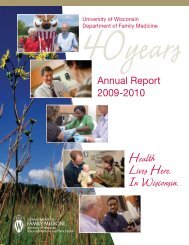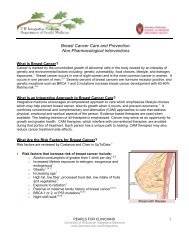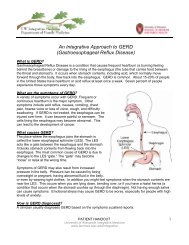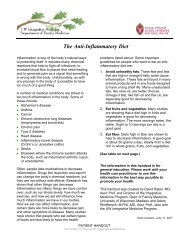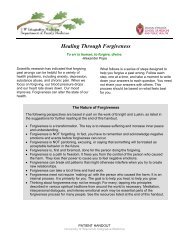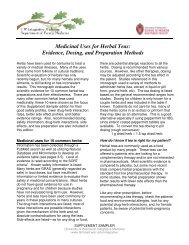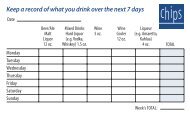Teach-Back - UW Family Medicine
Teach-Back - UW Family Medicine
Teach-Back - UW Family Medicine
You also want an ePaper? Increase the reach of your titles
YUMPU automatically turns print PDFs into web optimized ePapers that Google loves.
Promoting a Safe Transition from<br />
Hospital to Home Using the<br />
“<strong>Teach</strong>-<strong>Back</strong>” Process<br />
Cori Gibson, MSN, RN, CNL<br />
Cheryl Kornburger, BSN, RN<br />
Sandy Sadowski, RN
Learning Objectives<br />
• Describe how the “teach-back” process is a useful<br />
strategy to improve communication.<br />
• Explain how the “teach-back” process can be taught in<br />
short educational sessions.<br />
• Provide evidence that supports the use of this actionable<br />
intervention that can impact safety and quality outcomes<br />
during health care interactions.
<strong>Back</strong>ground and Significance<br />
• Health literacy<br />
– The ability to read, understand and act on health information<br />
• Why does health literacy matter<br />
– People with low health literacy have:<br />
• Poorer health overall<br />
• Higher death rates<br />
• More ER visits<br />
• Higher healthcare costs<br />
• More missed appointments<br />
• Literacy skills are a stronger predictor of an individual’s<br />
health status than age, income, employment status,<br />
education level or racial/ethnic group<br />
(Sanders et al., 2009; Villaire & Mayer, 2007; Weiss, 2007)
<strong>Back</strong>ground and Significance<br />
• Children are at greater risk for poor health outcomes if<br />
their caregivers have limited literacy skills<br />
• Chronically ill children with caregivers with low health<br />
literacy skills are twice as likely to use more health<br />
services<br />
(Lerret, 2009; Sanders et al., 2009; Weiss et al., 2008)
<strong>Back</strong>ground and Significance<br />
• Hospitalized children and their families are often not<br />
adequately prepared for discharge<br />
– Shorter hospital stays<br />
– Complex discharge instructions<br />
– Low health literacy skills<br />
– No standardized process for providing discharge education<br />
– Missed opportunities to assess understanding of teaching<br />
(Burkhart, 2008; Lerret, 2009; London, 2004; Paul, 2008; Sanders et al., 2009; Weiss et al., 2008)
<strong>Back</strong>ground and Significance<br />
• Health care professionals need to make sure families<br />
have the skills necessary to care for their children at<br />
home<br />
• Nurses are in a unique position to assess families’<br />
understanding of discharge teaching and can have a<br />
positive impact on the transition from hospital to home<br />
(Burkhart, 2008; Lerret, 2009; London, 2004; Paul, 2008; Weiss et al., 2008)
“<strong>Teach</strong>-<strong>Back</strong>” Process<br />
• Improves ability to assess understanding of<br />
teaching<br />
• Allows feedback and corrections of<br />
misunderstandings immediately<br />
• Encourages active family participation<br />
• Increases confidence to provide care at home<br />
• Improves transition from hospital to home<br />
• Improves overall safety and quality of care<br />
(Burkhart, 2008; Kemp et al., 2008; Kripalani & Weiss, 2006)<br />
( NQF, 2005; NQF, 2009; Weiss, 2007)
“<strong>Teach</strong>-<strong>Back</strong>” Project Intervention<br />
Developed in collaboration with Educational Services at Children’s Hospital of WI, September 2010
Evidence Based Practice Project<br />
• Examined the effect of an educational intervention for<br />
nurses on the “teach-back” process<br />
• Goals:<br />
– Increase nurse awareness of the prevalence and impact of low<br />
health literacy on health outcomes<br />
– Educate nurses on how to use the “teach-back” process as well<br />
as to check for understanding<br />
– Assist nurses to recognize and identify teachable moments<br />
throughout a patient’s hospital stay<br />
– Encourage nurses to incorporate the “teach-back” process into<br />
current teaching practices
Sample and Setting<br />
• 74 registered nurses working at Children’s Hospital of WI<br />
– 40 (inpatient surgical unit (W9))<br />
– 34 (inpatient medical unit (C7))<br />
Framework<br />
• Iowa Model of Evidence Based Practice
Methodology<br />
• Descriptive pre/post test design<br />
• Eight week project, on each unit, consisting of<br />
anonymous pre and post surveys and a 20 minute staff<br />
in-service using posters, videos, and role-playing of the<br />
“teach-back” process<br />
• Completed during normal staffing hours at minimal cost<br />
to unit
Methodology<br />
Educational Intervention<br />
• Pre-survey of nurses (survey monkey)<br />
– Self evaluation of prior knowledge on health literacy and<br />
“teach-back”<br />
• Poster presentation on health literacy and “teachback”<br />
and 5 minute health literacy video in conference<br />
room on unit<br />
– Staff nurses to view video and read posters prior to<br />
attendance of educational intervention
Methodology<br />
Educational Intervention<br />
• 20 minute educational sessions on unit<br />
– 10 minute instructional video on “teach-back” process<br />
– Role modeling and role playing<br />
– Instructions on documenting “teach-back”<br />
– Sharing of experiences<br />
– Laminated ID cards with key points<br />
• 4 week pilot to allow RNs to use new skills related to<br />
“teach-back”<br />
– Email reminders and flyers on unit<br />
• Post surveys of nurses (survey monkey)
Results/Outcomes<br />
• Fifty-eight pre-survey and fifty-three post<br />
survey responses were compared<br />
• Three main themes were identified<br />
– Knowing<br />
– Doing<br />
– Valuing
Results/Outcomes<br />
Theme: Knowing<br />
100%<br />
80%<br />
60%<br />
40%<br />
20%<br />
0%<br />
Do you know what the term "health literacy"<br />
means<br />
67.2%<br />
92.5%<br />
31.0%<br />
7.5%<br />
3.4%<br />
Yes Not sure No<br />
0.0%<br />
Pre Survey<br />
Post Survey<br />
N size Pre = 58 N size Post = 53<br />
Prepared in collaboration with the Outcomes Department, Dec. 2010
Results/Outcomes<br />
Theme: Knowing<br />
Are you familiar with the "teach-back" process<br />
100%<br />
80%<br />
60%<br />
40%<br />
63.8%<br />
100.0%<br />
31.0%<br />
20%<br />
0%<br />
8.6%<br />
0.0%<br />
0.0%<br />
Yes Not sure No<br />
Pre Survey<br />
Post Survey<br />
N size Pre = 58 N size Post = 53<br />
Prepared in collaboration with the Outcomes Department, Dec. 2010
Results/Outcomes<br />
Theme: Doing<br />
100%<br />
80%<br />
60%<br />
40%<br />
20%<br />
0%<br />
Do you currently use "teach-back" in your<br />
nursing practice<br />
3.4%<br />
45.1%<br />
82.8%<br />
54.9%<br />
15.5%<br />
Always Sometimes Never<br />
0.0%<br />
Pre Survey<br />
Post Survey<br />
N size Pre = 58 N size Post = 51<br />
Prepared in collaboration with the Outcomes Department, Dec. 2010
Results/Outcomes<br />
Theme: Doing<br />
How do you ask patients and families to assess<br />
their understanding (Check all that apply)<br />
100%<br />
80%<br />
60%<br />
40%<br />
20%<br />
0%<br />
91.4%<br />
50.9%<br />
Do you have any<br />
questions<br />
73.6%<br />
46.6%<br />
34.0%<br />
22.4%<br />
Do you understand Other (please specify)<br />
Pre Survey Post Survey<br />
N size Pre = 58 N size Post = 53<br />
Prepared in collaboration with the Outcomes Department, Dec. 2010
Results/Outcomes<br />
Theme: Valuing<br />
• 98% felt “teach-back” helps patients and families to<br />
better understand their discharge instructions<br />
• Described the “teach-back” process as useful, valuable<br />
and simple, a great idea, and something everyone<br />
should use<br />
• 58% were able to clarify information and correct<br />
misunderstandings by using the “teach-back” process<br />
– 80% related to medication administration (W9)<br />
– Formula dilutions<br />
– Follow-up appointments
Results/Outcomes<br />
Barriers<br />
• Time<br />
– Nurse workload<br />
– <strong>Family</strong> time constraints<br />
• Language<br />
• Nurse perceptions of adequacy of teaching<br />
• Perceived parents’ lack of interest in learning
Conclusions<br />
• Educational intervention improved nurses’ use and<br />
understanding of the “teach-back” process<br />
• Empowered nurses to verify understanding, correct<br />
inaccurate information and reinforce medication<br />
teaching and new home care skills<br />
• Findings specifically demonstrated the importance<br />
“teach-back” could have on preventing medication<br />
errors
“<strong>Teach</strong>-<strong>Back</strong>” Strategy Alignment with<br />
National Action Plan<br />
• Goal 2<br />
– Promoting changes in the healthcare delivery system<br />
– Improving communication of health information<br />
between health care professionals and recipients of<br />
health care<br />
• Goal 7<br />
– Promote the use of evidence-based health literacy<br />
practices and interventions
Implications<br />
• “<strong>Teach</strong>-back” process is valuable<br />
• Using “teach-back” will impact the quality and safety<br />
of care to pediatric patients and their families<br />
• Short educational interventions can make a great<br />
impact on nursing practice<br />
• Barriers to using “teach-back” need to be addressed<br />
• “<strong>Teach</strong>-back” process can promote a safer transition<br />
from hospital to home
What other<br />
questions do<br />
you have
References<br />
• Burkhart, J. (2008). Training nurses to be teachers. The Journal of<br />
Continuing Education in Nursing, 39 (11), 503-510.<br />
• Kemp, E., Floyd, M., McCord-Duncan, E., & Lang, F. (2008). Patients prefer<br />
the method of “tell back collaborative inquiry” to assess understanding of<br />
medical information. JABFM, 21 (1), 24-30.<br />
• Kripalani, S., & Weiss, B. (2006). <strong>Teach</strong>ing about health literacy and clear<br />
communication. Journal of General Internal <strong>Medicine</strong>, 21, 888-890.<br />
• Lerret, S. M. (2009). Discharge readiness: An integrative review focusing<br />
on discharge following pediatric hospitalization. Journal for Specialists in<br />
Pediatric Nursing, 14 (4), 245-255.<br />
• London, F. (2004). How to prepare families for discharge in the limited time<br />
available. Pediatric Nursing, 30 (3), 212-227.<br />
• National Quality Forum. (2005). Improving patient safety through informed<br />
consent for patients with limited health literacy. Washington, DC: NQF.
References<br />
• National Quality Forum. (2009, March). Health literacy: A linchpin in<br />
achieving national goals for health and healthcare (Issue Brief No. 13).<br />
Washington, DC: National Quality Forum.<br />
• Paul, S. (2008). Hospital discharge education for patients with heart<br />
failure: What really works and what is the evidence Critical Care Nurse, 28<br />
(2), 66-68.<br />
• Sanders, L. M., Federico, S., Klass, P., Abrams, M. A., & Dreyer, B. (2009).<br />
Literacy and child health: A systematic review. Archives of Pediatrics &<br />
Adolescent <strong>Medicine</strong>, 163 (2), 131-140.<br />
• Villaire, M., & Mayer, G. (2007). Low health literacy: The impact on chronic<br />
illness management. Professional Case Management, 12 (4), 213-216.<br />
• Weiss, B. D. (2007). Health literacy and patient safety: Help patients<br />
understand: Manual for Clinicians (2nd ed.). Chicago: American Medical<br />
Association.<br />
• Weiss, M., Johnson, N. L., Malin, S., Jerofke, T., Lang, C., & Sherburne, E.<br />
(2008). Readiness for discharge in parents of hospitalized children. Journal<br />
of Pediatric Nursing, 23 (4), 282-295.






